Disclosure: Meeple Mountain received a free copy of this product in exchange for an honest, unbiased review. This review is not intended to be an endorsement.
As much as I don’t like Magic: the Gathering or the predatory business model the game has behind it, I can’t ignore its influence. While Magic didn’t invent the idea of “do what the card says” as its gameplay mechanism, it certainly popularized the idea.
Almost every board game nowadays has some form of card text narrating the game’s strategic experience. It has appeared in all sorts of genres, from deckbuilders to co-operatives. One genre I was not expecting this to be in was gambling games.
Welcome to the DnD World!
Released in 2005, Three Dragon Ante is a fictional gambling game set in the Dungeons & Dragons universe. Inside the cheap red tuck box were strangely shaped, difficult to shuffle cards, and a rulebook expecting you to provide components to keep track of the money. Board gaming in the 2000s was wonderfully dumb.
While it didn’t exactly set the world on dragonfire, it did gain a following. That was enough for a sequel called Emperor’s Gambit in 2009. It was a similar game with added mechanisms and complexity for the “gamer” crowd.
For an entire decade, this game was forgotten until Wizkids raided its tomb in 2019. WizKids released a Legendary Edition of the game, combining some elements from the expansion and original game. Thankfully, the cards are of a standard size and shape, and they come with cardboard coins—although at the worst dominations of 1s and 10s. Not 5s.
The story does not end there. In 2022, the Giants War expansion was released. Yes, they released an expansion for a nearly 20-year-old game. I can’t say I’m surprised because we are seeing reprints of Reiner Knizia’s games that are older than that. I guess we are in a time where board games are trying to pull a Hollywood on us.
Of course, to give some context of what Giants War adds to the game, I need to start with Three Dragon Ante Legendary Edition.
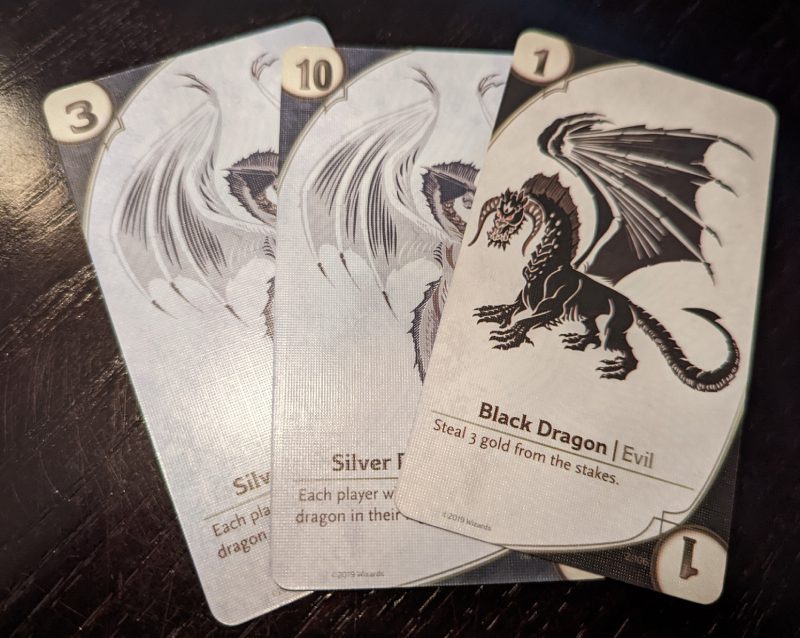
No flops, turns, or rivers here
Since this is a gambling game, the goal is obvious: Have the most money. The only way the game can end is if one person has money “in the hole” and cannot pay it back at the end of the gambit. Gambit is the game’s fancy way of saying round.
Everyone starts with a hand of five cards and some starting cash. Each card has a strength number, color, alignment, and ability.
Each gambit starts with an Ante. You and your friends have to throw in a card, and the highest number is this gambit’s ante. If the highest number is 9, everyone has to throw 9 gold into the stakes. The player who played the highest ante card also leads the first round of the gambit.
From there, the game is easily understandable. The player leading the round plays a card from their hand face up in front of them, and the card’s ability is triggered. The next player will play a card, but that ability is only triggered if it’s equal to or lower than the strength number of the previously played card. This keeps going until everyone has played at least one card.
Whoever played the highest card leads the next round, and this continues until three cards are in front of everyone. These cards are known as a flight. Whoever has the strongest flight, meaning the highest number, wins the stakes. Everyone keeps their hands and draws two cards, and a new gambit begins.
It’s not a challenging game to play, yet I will state that every time I taught this game to a new crowd, there were always looks of confusion. This didn’t surprise me since this game is unorthodox.
A lot of the unorthodox vibe comes from the use of abilities. Evil aligned cards focus more on screwing over other players, such as stealing their money and cards or an involuntary withdrawal from the stakes. Good aligned cards center around hand building, such as drawing cards from the deck or ante pile. The abilities of Mortal cards can drastically change the situation, while Legendary cards may contain Gods that can impact the gambit’s outcome.
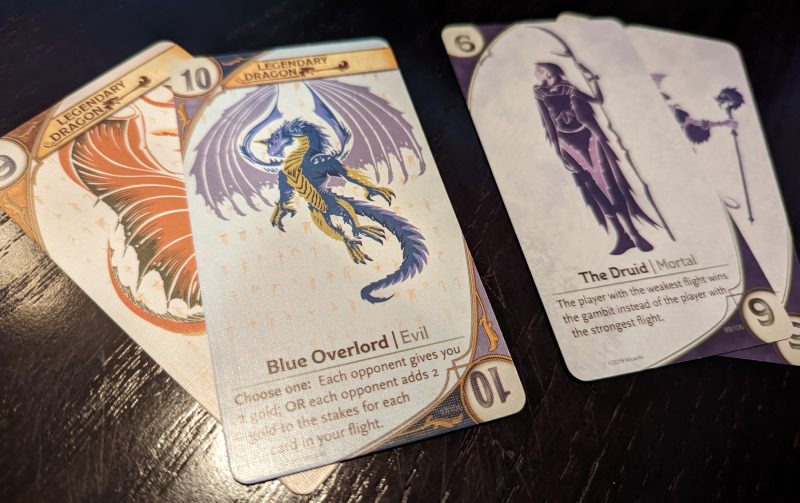
Almost as nonsensical as cribbage
Besides abilities, there are two different types of flights. Colored flights mean three cards in your flight are the same color, rewarding you by stealing from everyone. Strength flight is where all three of your cards have the same number, and you steal that from the stakes with the added bonus of taking cards from the ante pile.
The gameplay is quite unpoker-like, as you can probably tell. It has some elements of a card gambling game, such as looking at your hand and understanding the situation. Unlike gambling games, where you can fold if you think you aren’t going to make it, you are stuck on this train ride.
As you play each gambit, you must choose whether to use your strength numbers to win the stakes or to utilize your abilities to make the most of this situation. Choosing the ability route means you have to rely on the previous player not to play low-number cards. That sounds bad, yet you sometimes want to play a high-numbered card to start the next round of gambit and trigger your other ability. Similarly to fencing, there is back and forth in momentum, and your job is to decide when you should strike or lay low.
All these elements create this tiny community on your table that is akin to an American Thanksgiving Dinner™ with less bloodshed. Your buddy across the table is playing red and black dragons, stealing cards, and taking everyone’s money to be the punk on the table. Meanwhile, Catherine on your left just finished her color flight and is taking everyone’s money. This wouldn’t be so bad, but you’re in the hole right now, and you needed to win this gambit.
What is intriguing about Three Dragon Ante is everyone is doing their bit on the table, yet the pacing crack whips the table with ease. There is little friction here, and it gives the game more credibility than you think because of these competing objectives driven by human interpretation. For a game based on a mid-2000s design, it holds up quite well.
It’s also the mid-2000s design that makes me dislike quite a few areas.
2000s aftertaste
The first obvious one is the player scaling. Don’t bother with five or six players. Not only does it have a lot of downtime between turns to play your cards, but it also makes the game far more chaotic. Abilities fire off all over the place like it’s an American civil war re-enactment.
This leads to the issue of Mortal and Legendary Cards. Some gambits can feel like a complete wash since you might have a great plan, only to be messed up by a single card or two to throw everything off. Sometimes, the luckiest can win, and that is often the case during critical moments for Three Dragon Ante.
Like any other game in the 2000s, the time on the side of the box is a lie. 30 minutes? Double that. As long as people are winning the stake evenly, the game can potentially go forever, since the only way for it to end is if someone becomes bankrupt. There’s nothing deep about this game either, as sometimes your action plan is obvious, making the repetitive nature of the game kick in when it overstays its welcome.
An impressive game that stood the test of time despite the kinks left over by the dust of older game design philosophy. It’s good, but not great.
Does the Giant Wars expansion fix all the issues? Yes.
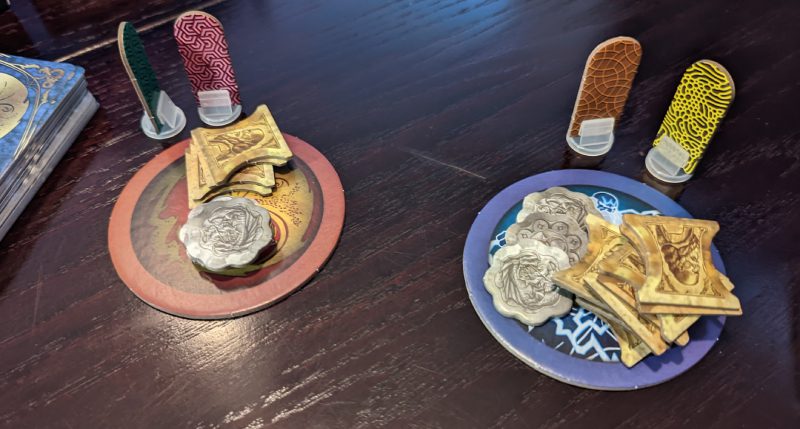
Giants and Dragons, 2nd Edition
Obviously, the name of the expansion is a giveaway that this one adds Giants to the mix. Like the Dragons, they have their own abilities, alignments, and strength numbers. There’s a crucial change: There are two stakes. One for Giants and one for Dragons.
When you play a Giant or Dragon, their strength contributes towards the stake of the same type. Playing a Mortal is a bit different as you have to declare what side they are on immediately after putting it on the table.
The result of this massive change doesn’t stop there. During the Ante, the two highest numbers contribute to the two stakes. The original game gave you some leeway when you lose, but a loss can be devastating since you are technically paying twice the amount than usual for ante.
By the third gambit, it’s uncommon for a player to be in danger of losing their money. It submerges everyone into danger as they desperately move their feet to stay afloat. There is far more weight put into these gambits, and it forces everyone to examine the situation with the same voracity as a CSI investigator
Fortunately, these changes go beyond the two stakes. Even the Legendary and Mortals are now separated from the main deck and are called the Legendary deck. At the start of the game, six Legendary cards are shuffled into the main deck, still giving that extra bit of chaos the game does need, yet more gradually and acceptably. There are also new abilities that allow you to draw Legendary cards.
The last bit is ending the game. There is now another way the game ends, and that’s by the reshuffling of the main deck. After reshuffling the main deck, only three gambits remain, and then the game ends. No more perpetual loop nonsense like in the original.

Act like a gambler, talk like a gambler
Besides these improvements that fix my ills towards the original, I also like the new ways you can approach this social puzzle.
In the original game, you decide whether to try to win the gambit or throw in abilities to help you out in the future and barely beyond that. The two stakes still make this mindset viable, yet there are several new tactics for you to exploit.
One is the act of misdirection. You have no idea what stakes I’m aiming for if a Dragon 8 and a Giant 9 are in my flight. I could have a Legendary card in my hand or a Mortal that allows me to be flexible. Something like this can smoke bomb the entire situation and throw everyone’s decision matrix out of the loop. Due to the single stake nature of the original, something like this wasn’t possible at all.
The two stakes also make the game more engaging, since winning some cash is a higher possibility. Instead of one stake, you have two stakes, and gambling games should give you that dopamine hit when you win fake money to dump into your pile.
As for five or six players, it does improve the experience by a large margin since six people competing for one stake was quite annoying. I’m still not convinced that this is worth the extra downtime. At least it feels more functional than the original, and I prefer three or four people.
The original Three Dragon Ante was ahead of its time and still has a bit of fight despite some of its quirks. Giants War elevates Three Dragon Ante into a sharper and more structured experience. Unless you aren’t a fan of games that can be driven by luck or dislike gambling, it’s hard not to suggest trying this one out.


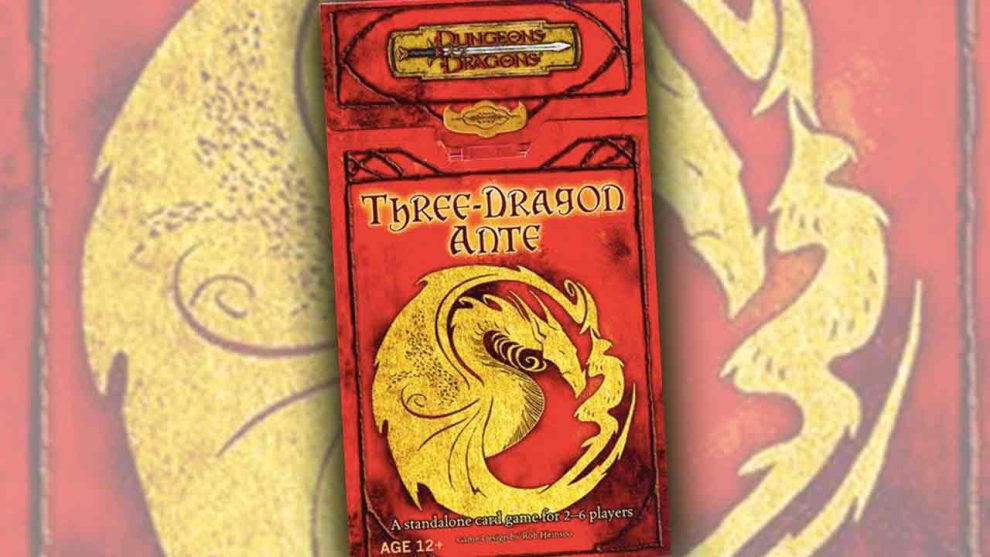

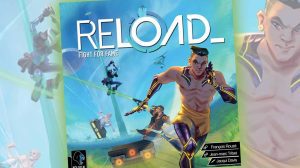

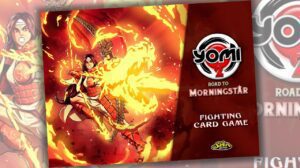
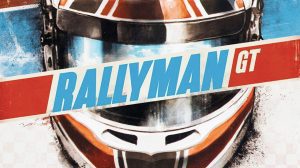




Add Comment